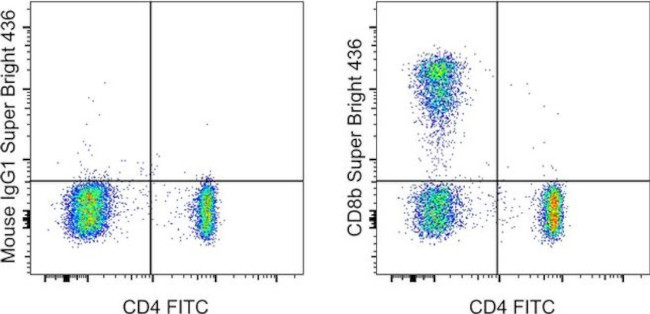Search Thermo Fisher Scientific
Invitrogen
CD8b Monoclonal Antibody (SIDI8BEE), Super Bright™ 436, eBioscience™
FIGURE: 1 / 1
CD8b Antibody (62-5273-42) in Flow

Product Details
62-5273-42
Species Reactivity
Host/Isotype
Recommended Isotype Control
Class
Type
Clone
Conjugate
Excitation/Emission Max
Form
Concentration
Purification
Storage buffer
Contains
Storage conditions
Shipping conditions
RRID
Product Specific Information
Description: The SIDI8BEE monoclonal antibody reacts with human and rhesus macaque CD8 beta. The CD8b chain associates with the CD8a chain to form the CD8ab heterodimer expressed on the surface of a majority of thymocytes, and on peripheral cytotoxic alpha beta TCR T cells. The CD8 receptor complex binds to MHC class I and plays a role in T cell development and activation of mature T cells. Long been thought to exist either as a heterodimer of the alpha and beta chain or as a homodimer of alpha chains, beta chains have now been shown to homodimerize as well. SIDI8BEE can detect the CD8 beta chain in both the CD8ab heterodimer and the CD8bb homodimer.
SIDI8BEE is cross-reactive to human and rhesus macaque CD8b. Other non-human primate species have not been tested.
Applications Reported: This SIDI8BEE antibody has been reported for use in flow cytometric analysis.
Applications Tested: This SIDI8BEE antibody has been pre-titrated and tested by flow cytometric analysis of human peripheral blood lymphocytes. This can be used at 5 µL (0.125 µg) per test. A test is defined as the amount (µg) of antibody that will stain a cell sample in a final volume of 100 µL. Cell number should be determined empirically but can range from 10^5 to 10^8 cells/test.
Super Bright 436 can be excited with the violet laser line (405 nm) and emits at 436 nm. We recommend using a 450/50 bandpass filter, or equivalent. Please make sure that your instrument is capable of detecting this fluorochrome.
When using two or more Super Bright dye-conjugated antibodies in a staining panel, it is recommended to use Super Bright Complete Staining Buffer (Product # SB-4401) to minimize any non-specific polymer interactions. Please refer to the datasheet for Super Bright Staining Buffer for more information.
Excitation: 405 nm; Emission: 436 nm; Laser: Violet Laser
Super Bright Polymer Dyes are sold under license from Becton, Dickinson and Company.
Target Information
The CD8B antigen is a cell surface glycoprotein found on most cytotoxic T lymphocytes that mediates efficient cell-cell interactions within the immune system. The CD8 antigen, acting as a coreceptor, and the T-cell receptor on the T lymphocyte recognize antigens displayed by an antigen presenting cell (APC) in the context of class I MHC molecules. The functional coreceptor is either a homodimer composed of two alpha chains, or a heterodimer composed of one alpha and one beta chain. Both alpha and beta chains share significant homology to immunoglobulin variable light chains. This gene encodes the CD8 beta chain isoforms. Multiple alternatively spliced transcript variants encoding distinct membrane associated or secreted isoforms have been described. A pseudogene, also located on chromosome 2, has been identified.
For Research Use Only. Not for use in diagnostic procedures. Not for resale without express authorization.
How to use the Panel Builder
Watch the video to learn how to use the Invitrogen Flow Cytometry Panel Builder to build your next flow cytometry panel in 5 easy steps.
References (0)
Bioinformatics
Protein Aliases: CD8; CD8 antigen, beta polypeptide 1 (p37); CD8alpha; CD8b; CD8beta; Leu-2; MAL; T lymphocyte surface glycoprotein beta chain; T-cell surface glycoprotein CD8 beta chain
Gene Aliases: CD8B; CD8B1; LEU2; LY3; LYT3; P37
UniProt ID: (Human) P10966
Entrez Gene ID: (Human) 926

Performance Guarantee
If an Invitrogen™ antibody doesn't perform as described on our website or datasheet,we'll replace the product at no cost to you, or provide you with a credit for a future purchase.*
Learn more
We're here to help
Get expert recommendations for common problems or connect directly with an on staff expert for technical assistance related to applications, equipment and general product use.
Contact tech support

